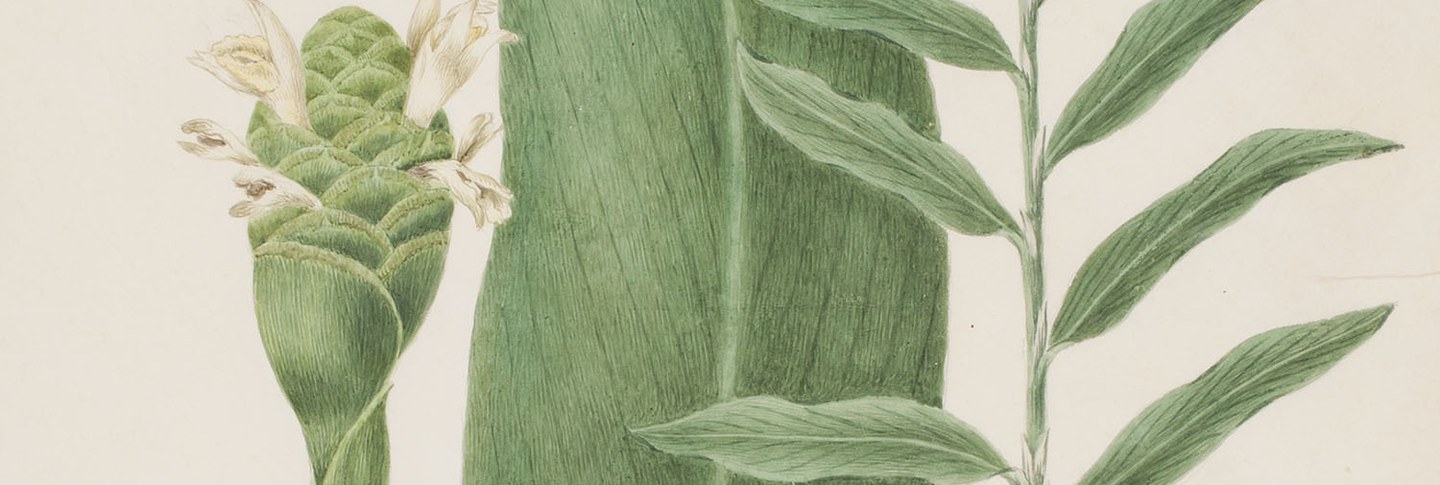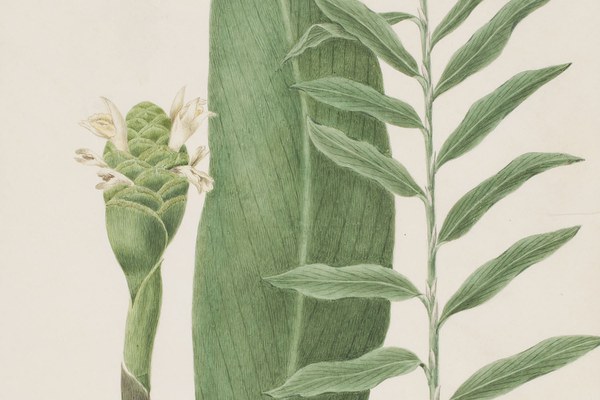Databases, library collections, and projects of interest to plant humanities research topics, including biodiversity, ethnobotany, botanical illustration and artwork, medicine, and scientific exploration.
Databases Library Collections Projects
Databases
- The Biodiversity Heritage Library (BHL) is the world’s largest open-access digital library for biodiversity literature and archives. Contributing research institutions and botanical libraries digitize the natural history literature held in their collections and make these resources freely available through BHL.
- Good for: locating digitized rare books, full-text searching, indexed scientific names
- Search help: A Harvard Library guide offers search tips, an introduction to BHL’s advanced features, and instructions for downloading content.
- The Medical Heritage Library, Inc., is a collaborative digitization and discovery organization committed to providing open-access resources in the history of healthcare and the health sciences. Like the Biodiversity Heritage Library, the Medical Heritage Library is composed of resources that have been digitized by member institutions.
- Good for: locating digitized rare books, particularly herbals and other medical texts; full-text searching
- Search help: a guide to using the full-text search tool is available on the MHL’s website.
- Native American Ethnobotany is an online database of foods, drugs, dyes, fibers and other plant derivatives used by Native American Peoples. The database contains over 44,000 items, representing uses by 291 Native American groups of 4,029 species from 243 different plant families. Each record links to the US Department of Agriculture PLANTS database, which contains complete botanical information on useful plants, including pictures, range maps, and endangered status.
- Good for: discovering how plant species were used by Native American Peoples, locating secondary sources related to ethnobotany in North America
- Search help: the database allows you to perform a basic keyword search or filter results by tribe or use category (Drug, Dye, Fiber, Food, Other). In addition to a target search, you can also browse a list of all tribes or plant species.
- For example, you can see all documented uses of Mentha spicata L. (Spearmint). Each record describes a specific use for the plant within an individual tribe, gives a citation for that use, and links to the USDA PLANTS database. You can click on the tribe name in the search results list to view all plants used by that tribe.
- Hunt Institute for Botanical Documentation at Carnegie Mellon University focuses on the development of botany as a science. The collection contains botanical publications dating from the late 1400s, including early agricultural and horticultural works, 17th- through 19th-century color-plate books, modern taxonomic monographs, floristic works, and serial titles in the plant sciences. The Hunt Institute has created several databases to help scholars navigate their extensive collection; select databases are highlighted below.
- The Floras database is a searchable bibliography of nearly 4,000 titles of the world’s floristic literature published in the period 1730–1840. The term flora is generally understood to designate literature which treats in any way the distribution or identification of plants from particular geographic areas; the defining characteristic of this genre is the regional approach.
- Good for: locating books that deal with only a single geographic area, searching for plants by region
- The collection of botanical art and illustration in the Art Department at the Hunt Institute is one of the world's largest and most broadly representative. It includes over 30,000 original works—paintings (mostly watercolors), drawings and original prints—dating from the Renaissance onward. In addition to the more general Catalogue of the Botanical Art Collection, the Hunt Institute has provided an index to digitized images from their collection that are in the public domain.
- Good for: finding public domain images
- The Torner Collection of Sessé and Mociño Biological Illustrations is the original collection of botanical and zoological illustrations made during the Spanish expedition of 1787–1803 under the command of Martin de Sessé y Lacasta (1751–1808) and José Mariano Mociño (1757–1820). The Sessé and Mociño expedition, as it is commonly called, explored extensively in the Caribbean, Mexico and northern Central America, with forays also in Baja and Alta California and as far north as Nootka and Alaska. The collection comprises approximately 2,000 watercolor drawings and sketches, around 1,800 of which are of botanical subjects.
- Good for: finding public domain images
- The 186 original Linnaean dissertations, published between 1743 and 1776, were the joint products of Carolus Linnaeus (1707–1778) and his students. Their subject matter included such diverse topics as Baltic coral, the flora of England, insects, medical botany, the botanical garden at Uppsala, dogs and chocolate. The Hunt Institute’s database of the Original Linnaean Dissertations includes in each entry a PDF of the original dissertation, an English summary, respondent, title, date of defense, pagination, short title, and notes.
Library Collections
- The Council on Botanical and Horticultural Libraries (CBHL) lists member Plant Libraries, many of which have made portions of their collections available online.
- The Botanical Illustrations exhibit on Harvard Digital Collections provides free, public access to objects digitized from the Botany Libraries. The original works of art in this collection of botanical illustrations date from the early 1800s to the mid-1900s and include works by Harvard botanists, professional artists, “amateur” women who studied plants, and others.
- New York Botanical Garden’s LuEsther T. Mertz Library collects works pertaining to the fields of botanical science, horticulture, and landscape and garden design. In addition to their digitized materials, which include curated selections of Latin American Plant Literature, Great Flower Books, Books on Trees, and Botanical Art, the Mertz Library has created extensive research guides for their physical collection and exhibitions and a list of relevant databases.
- The Oak Spring Garden Library comprises a collection of over 19,000 objects, including rare books, manuscripts, and works of art dating back to the fourteenth century. The collection mainly encompasses works relating to horticulture, landscape design, botany, natural history, and voyages of exploration. Oak Spring has published four catalogs of their collection, which they have made available as searchable e-books.
- The library of Christoph Jacob Trew, an 18th-century physician and scientist of Nuremberg, is one of the largest private collections of science books in the German-speaking countries. Over several decades, Trew gathered 34,000 books, relating mainly to medicine and science, 19,000 scholarly letters dating from the 16th through the 18th centuries, as well as an extensive natural history collection, which are housed at the University of Erlangen-Nuremberg. The university has also digitized several other examples of botanical literature.
- The John Carter Brown Library is an independently funded research library located on the campus of Brown University. The collection, which includes books, maps, and manuscripts related to the history of the Americas from the late-fifteenth century until the middle of the nineteenth century, has increasingly emphasized indigenous language materials and other sources related to America’s earliest indigenous inhabitants. The library’s digital collections can be accessed through LUNA or through the Internet Archive.
- The Digital Library del Real Jardin Botanico CSIC (Madrid) is an online botanical information resource that provides free and open access to more than 7,500 publications, primarily drawn from the collection of the Library of the Royal Botanical Garden.
- The Peter H. Raven Library at the Missouri Botanical Garden contains more than 250,000 books, botanical artwork, field books, photographs, and modern and historical maps. The collection’s focus is on plant names and descriptions, but the Library is also rich in other subjects such as the study of edible and medicinal plants, the art of botanical illustration, and the history of scientific exploration. Digitized materials are available through Botanicus Digital Library or through BHL.
- In addition to providing access to their own digitized monographs, plant catalogs, and periodicals, the German Horticultural Library has compiled extensive bibliographies of digitized garden literature from other institutions.
- The Special Collections of Leiden University offer a wealth of research materials for the exploration of the Netherlands’ engagement with Asia, Africa and the Americas from the late sixteenth century onwards. Moreover, the library collections of the Royal Institute for the Tropics (KIT), the Royal Netherlands Institute of Southeast Asian and Caribbean Studies (KITLV) and the former library of the Dutch Ministry of Colonies – all of which are presently under the care of Leiden University Libraries – offer unrivalled opportunities for the study of the (colonial) history of Indonesia, Suriname and the Netherlands Antilles. Leiden University has digitized several of these collections pertaining to plant humanities and colonial botany, including:
- The Clusius Correspondence collection provides access to the digitized collection of letters written to and by the botanist Carolus Clusius (1526-1609), which are kept at Leiden University Library. The letters have been scanned in high resolution and the images can be viewed on screen or can be downloaded.
- The Colonial Sources of the Royal Tropical Institute (KIT) digital collection consists of over 2,860 publications related to the colonial enterprise in the Dutch East and West Indies. The publications are mainly in Dutch and cover the period of the last quarter of the eighteenth century to the middle of the twentieth century. They include titles on the cultivation of tropical products such as coffee, tea, sugar, tobacco and rubber, as well as trade and the colonial administration.
- Leiden University has also digitized Icones Plantarum Malabaricum, a collection of early 18th-century botanical drawings of medicinal plants from Dutch Ceylon, present-day Sri Lanka. In total, 245 species are described: cultivated garden plants and common weeds but also wild forest species and Sri Lankan endemics. Many species are used to purify the blood, to cure snakebites or to remove slime from the stomach. The detailed recipes show that the author had a good relation with traditional healers and local people, who were willing to share their knowledge with him.
Projects
- Welcome to the Ethnobotany Lab is a guide to resources for investigating the plants used by the ancient and modern Maya and Nahutal cultures. The site provides a detailed history of the various plant-based colorants used in Mesoamerican codices and includes short essays highlighting ethnobotanical subjects that give context to the plant descriptions. There is an emphasis on indigenous names drawn from a variety of linguistic and ethnographic sources and on the systematic plant classification system of the Nahua, including an explanation of the Nahua Glyphs used both in place name construction and plant identification.
- The resource was created by John Hessler, the curator of the Jay I. Kislak Collection of the Archaeology and History of the Early Americas at the Library of Congress. Hessler also gave a series of seminars on the Nahuatl and Mixtec maps held by the Library of Congress, with a particular focus on plant iconography. These seminars are available for free on Rare Book School’s website.
- The Early Modern Recipes Online Collective (EMROC) is a group of scholars and students creating transcriptions of manuscript recipe books written in English between 1550 and 1800. EMROC's efforts focus on making searchable, encoded versions of these texts freely available for scholars and the general public. This corpus is particularly useful for any scholars interested in how plants were used in cooking, home remedies, and other recipes. The original manuscripts and transcriptions are available on LUNA, and there are instructions for searching the collection on EMROC’s homepage.
- Drawing Flowers: Botanical Art and Illustration provides readers with a list of tutorials, including thorough instructions and prompts to start drawing botanical illustrations. It helps botany students and plant enthusiasts in general to learn about the history and relevance of botanical illustration, create their own botanical journals, identify plants, and design guides for classes, workshops, and other educational activities.
- Good for: learning how to identify and draw plants; designing educational activities.

